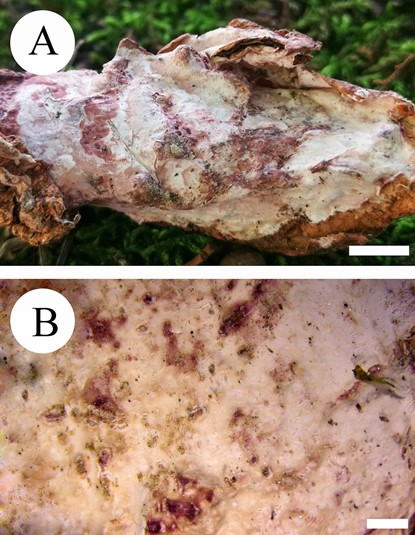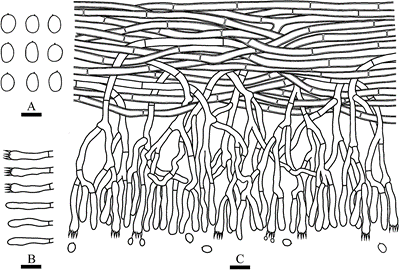Flavodontia rosea C.L. Zhao, sp. nov. Figs 3, 4
MycoBank number: MB 838323; Index Fungorum number: IF 838323; Facesoffungi number: FoF;
Differs from Flavodon flavus by its resupinate basidiomata with buff to slightly rose to rose hymenial surface, its monomitic hyphal structure, and its smaller basidiospores.
Type: China. Yunnan Province: Honghe, Pingbian County, Daweishan National Nature Reserve, 22.93°N 103.68°E, alt. 1714 m, on an angiosperm trunk, 3 August 2019, CLZhao 18491 (Holotype, SWFC 018491; GenBank MW377575, MW377578).
Etymology: From rosea (Lat.), referring to the rose hymenial surface of the basidiome.
Basidiomata annual, resupinate, coriaceous, without odour or taste when fresh, becoming fragile to rigid upon drying, ≤8 cm long, 3 cm wide, 500–800 µm thick. Hymenial surface smooth, buff to slightly rose to rose when fresh, becoming rose-coloured upon drying. Subiculum very thin, 0.2 mm thick, buff to slightly rose. Margin sterile, cream to buff, 2 mm wide. Hyphal structure monomitic; generative hyphae with simple septa, colourless, thin to thick-walled, rarely branched, 3–4.5 µm diam., IKI–, CB–; tissues unchanged in KOH. Hymenium cystidia and cystidioles absent; basidia clavate, 19–26.5 × 3–4 µm, with four sterigmata and a basal simple septum; basidioles dominant, in shape similar to basidia, but slightly smaller. Basidiospores ellipsoid, colourless, thin-walled, smooth, IKI–, CB–, (3.1–)3.3–4.6(–4.8) × (2.5–)2.7–3.5 µm, L = 3.99 µm, W = 3.06 µm, Q = 1.29–1.30 (n = 60/2).
Type of rot: white rot.
Additional specimen examined: CHINA. Yunnan province. Honghe: Pingbian County, Daweishan National Nature Reserve, on the angiosperm trunk, 3 August 2019, CLZhao 18489 (SWFC 018489; GenBank MW377574, MW377577).
Comments: Flavodon flavus differs from Flavodontia rosea by pileate basidiomata with a poroid hymenophore surface that becomes hydnoid to irpicoid with time, a dimitic hyphal structure with thick-walled skeletal hyphae, and larger basidiospores (5.5–6.5 × 3–4 µm; Ryvarden 1973).

Fig. 3. Flavodontia rosea (holotype, SWFC 018491). Basidiomata. Scale bars: A = 0.5 cm; B = 1 mm.

Fig. 4. Flavodontia rosea (drawn from the holotype, SWFC 018491). A. Basidiospores; B. Basidia and basidioles; C. Section of hymenium. Scale bars: A = 5 µm; B, C = 10 µm.
